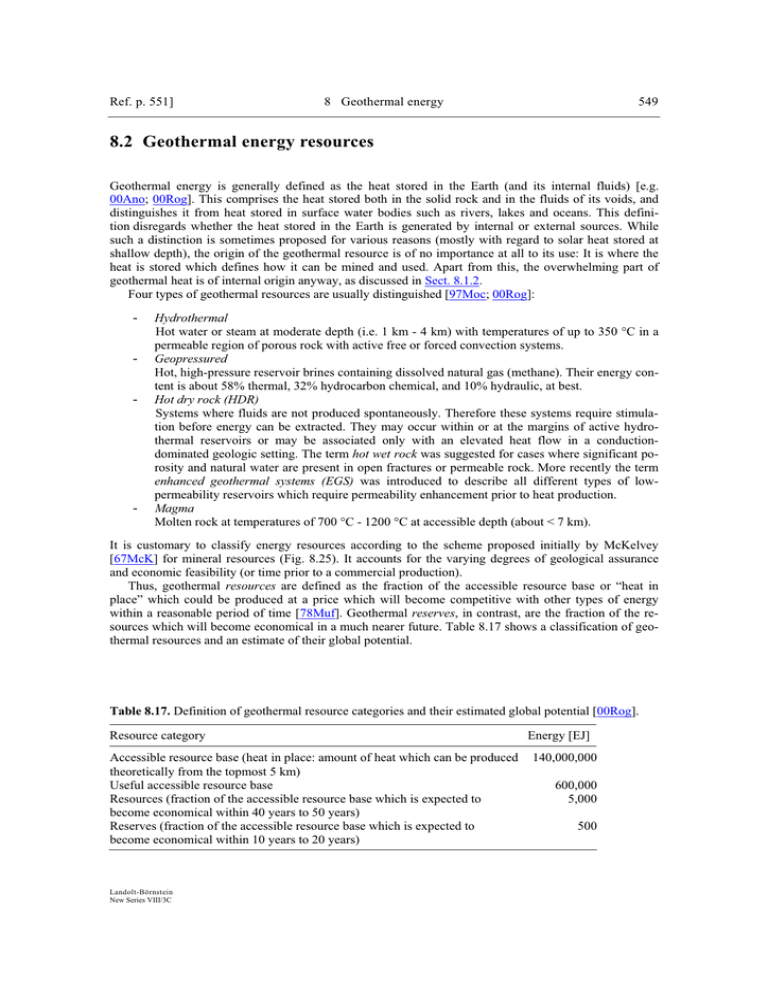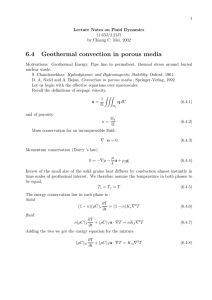8.2 Geothermal energy resources
advertisement

Ref. p. 551] 8 Geothermal energy 549 8.2 Geothermal energy resources Geothermal energy is generally defined as the heat stored in the Earth (and its internal fluids) [e.g. 00Ano; 00Rog]. This comprises the heat stored both in the solid rock and in the fluids of its voids, and distinguishes it from heat stored in surface water bodies such as rivers, lakes and oceans. This definition disregards whether the heat stored in the Earth is generated by internal or external sources. While such a distinction is sometimes proposed for various reasons (mostly with regard to solar heat stored at shallow depth), the origin of the geothermal resource is of no importance at all to its use: It is where the heat is stored which defines how it can be mined and used. Apart from this, the overwhelming part of geothermal heat is of internal origin anyway, as discussed in Sect. 8.1.2. Four types of geothermal resources are usually distinguished [97Moc; 00Rog]: - - Hydrothermal Hot water or steam at moderate depth (i.e. 1 km - 4 km) with temperatures of up to 350 °C in a permeable region of porous rock with active free or forced convection systems. Geopressured Hot, high-pressure reservoir brines containing dissolved natural gas (methane). Their energy content is about 58% thermal, 32% hydrocarbon chemical, and 10% hydraulic, at best. Hot dry rock (HDR) Systems where fluids are not produced spontaneously. Therefore these systems require stimulation before energy can be extracted. They may occur within or at the margins of active hydrothermal reservoirs or may be associated only with an elevated heat flow in a conductiondominated geologic setting. The term hot wet rock was suggested for cases where significant porosity and natural water are present in open fractures or permeable rock. More recently the term enhanced geothermal systems (EGS) was introduced to describe all different types of lowpermeability reservoirs which require permeability enhancement prior to heat production. Magma Molten rock at temperatures of 700 °C - 1200 °C at accessible depth (about < 7 km). It is customary to classify energy resources according to the scheme proposed initially by McKelvey [67McK] for mineral resources (Fig. 8.25). It accounts for the varying degrees of geological assurance and economic feasibility (or time prior to a commercial production). Thus, geothermal resources are defined as the fraction of the accessible resource base or “heat in place” which could be produced at a price which will become competitive with other types of energy within a reasonable period of time [78Muf]. Geothermal reserves, in contrast, are the fraction of the resources which will become economical in a much nearer future. Table 8.17 shows a classification of geothermal resources and an estimate of their global potential. Table 8.17. Definition of geothermal resource categories and their estimated global potential [00Rog]. Resource category Accessible resource base (heat in place: amount of heat which can be produced theoretically from the topmost 5 km) Useful accessible resource base Resources (fraction of the accessible resource base which is expected to become economical within 40 years to 50 years) Reserves (fraction of the accessible resource base which is expected to become economical within 10 years to 20 years) Landolt-Börnstein New Series VIII/3C Energy [EJ] 140,000,000 600,000 5,000 500 550 8.2 Geothermal energy resources [Ref. p. 551 Different recent estimates of the accessible geothermal resource base vary between 140,000,000 EJ [00Rog] and about 117,000,000 EJ [97Moc], i.e. by less than 20%. Table 8.18 shows that it is available world-wide. Only about 4% of this huge resource base is considered as useful and accessible, and of this again only about 1% are considered as resources. Finally, 10% of the resources, i.e. their most accessible part, are considered as reserves. Tiny as this might appear, this amount exceeds the global annual primary energy consumption of 420 EJ in the year 2001 [03IEA]. Therefore, and for its widespread availability on our planet at any time of the day and the year, “the technological ability to use geothermal energy, not its quantity, will determine its future share” [00Rog]. Fig. 8.25. McKelveydiagram [67McK] for classifying resources (modified after [00Rog]). Table 8.18. Accessible geothermal resource base by region [00Rog]. Region Energy [EJ] North America Latin America and Caribbean Western Europe Eastern Europe and former Soviet Union Middle East and North Africa Sub-Saharan Africa Pacific Asia (excl. China) China Central and South Asia Total 26,000,000 26,000,000 7,000,000 23,000,000 6,000,000 17,000,000 11,000,000 11,000,000 13,000,000 140,000,000 Percentage of world total 18.6 18.6 5.0 16.4 4.2 12.1 7.9 7.9 9.3 100.0 Landolt-Börnstein New Series VIII/3C 8 Geothermal Energy i 8.2.1 References for 8.2 67McK 78Muf 97Moc 00Ano 00Rog 03IEA McKelvey, V.E.: Am. Sci. 60 (1967) 32 - 40. Muffler, L.J.P., Cataldi, R.: Geothermics 7 (1978) 53 - 89. Mock, J.E., Tester, J.W., Wright, P.M.: Annu. Rev. Energy Environ. 22 (1979) 305 - 356. Anonymous: Thermal use of the underground; Part 1: Fundamentals, approvals, environmental aspects, VDI-Richtlinien VDI 4640/I, Düsseldorf: Verein dt. Ingenieure (VDI), 2000. Rogner, H.-H., in: Goldemberg, J., Baker, J.W., Ba-N’Daw, S., Khatib, H., Popescu, A., Viray, F.L. (eds): World Energy assessment, UN Development Program, New York: Bureau for Development Policy, 2000, p. 135 - 171; ( www.undp.org/seed/eap/activities/wea/ ). IEA (International Energy Agency): Key world energy statistics, Paris: IEA, 2003, p. 6.; (recent statistics see: www.iea.org/dbtw-wpd/Textbase/publications/index.asp ). Landolt-Börnstein New Series VIII/3C







